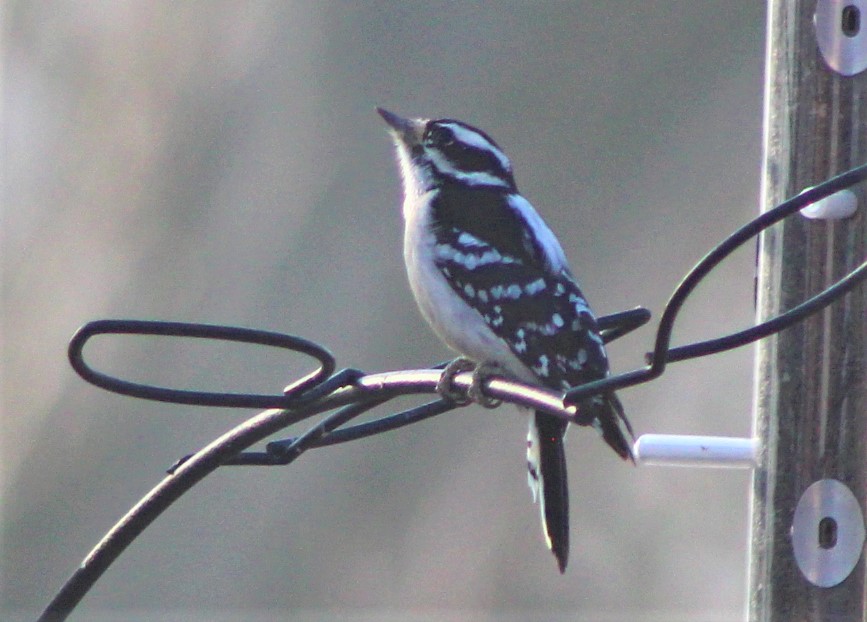We put a new mix of seed in the bird feeder this week. It has more corn and peanuts in it than the last batch. This morning seeds are scattered on the ground beneath the feeder. Here’s a chipmunk stuffing his cheek pouches with it. He runs away toward his burrow, then comes back empty-cheeked to get another load. Nearby, a pair of cardinals and a pair of blue jays forage among the peanuts and corn on the ground, sharing the field with the chipmunk. A red-bellied woodpecker cruises in for a snack. All the finches and juncos flew away when the bigger birds arrived. The downy woodpecker on the suet block holds his ground, enjoying his breakfast.
The downy woodpecker (Picoides pubescens) is native to North America and is small compared to other woodpeckers. He wears black plumage checked with white, bold stripes on his head, and a white stripe down the middle of his back. Underneath he is mostly white. His name comes from the soft, “downy” feathers that make up the white stripe on his back. This helps differentiate him from the hairy woodpecker, who has a similar marking but whose feathers are more hair-like.
Downy has a short, black, chisel-shaped bill surrounded at its base by a fringe of white bristles. These specialized feathers may act as a filter, helping protect him from breathing in the mold and sawdust created when he’s hammering on a tree. A more likely possibility is that they are sensory organs, measuring wind speed and direction. The captain of a sailboat once told me in all earnestness that the way I could tell if we were sailing into the wind was by noting the movement of the hair in my ears. I don’t have hair in my ears, but I’ve held that advice as true, and it’s similar to what these bristles might be doing.
Downy’s feet are gray, with two toes facing forward and two backward, ideal for perching and for stabilizing him when he’s hammering. Males and females look alike, except that the male wears a red patch on the nape of his neck. They weigh just under an ounce and are about 6 inches long. The wingspan averages three to four inches.
Like many small birds, Downy’s wings are relatively short and somewhat rounded. This wing shape gives him the ability to take off quickly and fly for short distances in a characteristic undulating pattern. As he flies, he executes a downstroke with his wings and then glides with them folded against his body. Then he repeats the downstroke.
Downy’s preferred food is insects, which he harvests from tree bark, rotting wood, plant galls and other likely places. He moves quickly sideways, up and down a tree trunk or branch, foraging in cracks and crevices for beetle larvae, ants, caterpillars and anything else he can find, including a variety of pests. About a quarter of his diet is seeds. He likes to sit up straight on a branch, using his stiff tail feathers to balance.
Like other woodpeckers, Downy drums on trees with his bill. He’s not drumming to find insects though. He feeds pretty quietly. The drumming is a song of sorts. He drums to communicate, especially to establish a territory, woo a mate, and converse with his mate once she says yes. He also uses his voice in cheeps and in a downward-spiraling song.
In the winter, he subscribes to the theory that there is safety in numbers, flocking together with chickadees, juncos and finches. During late winter, courting and mating will take place. Mr. Downy will help his lady excavate a nest in a tree branch with the opening on the underside of the branch. There they will raise a brood of three to eight young ones, working together to incubate, feed and fledge their offspring. We’ll hear them all summer drumming on hollow parts of trees, sending their messages of love and warning throughout the woods.
Because they are happy to live in edge areas with deciduous trees like the woods on Owl Acres, young or thinned forests and disturbed areas, downy woodpeckers are plentiful. With a breeding population estimated at 14 million, they can be found throughout North America, their native homeland.
Back at the bird feeder, we notice that the big birds have left again, and the little ones have returned. The chipmunk can’t believe his good luck and is still busy hoarding seeds. The downy woodpecker finishes his breakfast and moves off in that undulating flight, to be replaced quickly by a female downy woodpecker. Perhaps they will be mates?
Photo by Author

1 comment